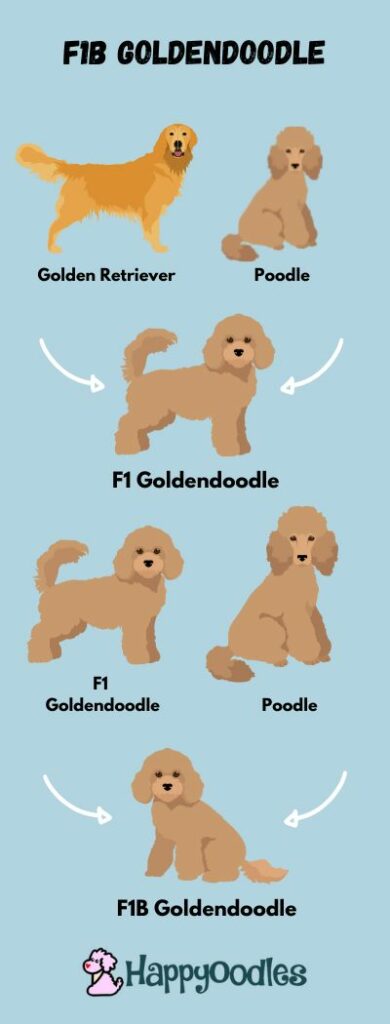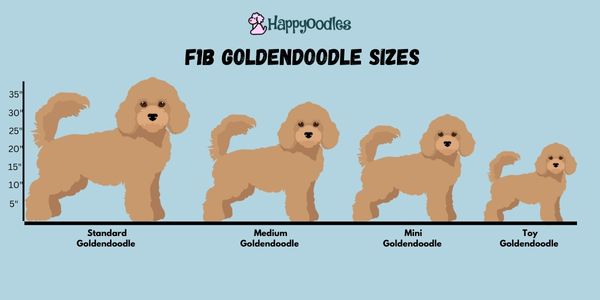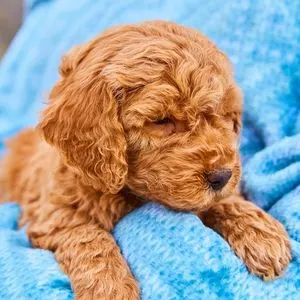Updated 02.13.2024 – Goldendoodles have swiftly become a favorite in the canine world, boasting a blend of the friendly charm of the golden retriever with the intelligence and allergy-friendly coats of the purebred poodle. But as with all doodle breeds, differences exist within their classifications. Each generation of Goldendoodles brings a unique set of attributes, and understanding these differences is vital for potential owners. The F1B Goldendoodle, in particular, stands out in this diverse lineup.
Resulting from a backcross between a Goldendoodle and a purebred poodle, the F1B Goldendoodle typically showcases a denser, more consistent hypoallergenic coat—making them an option for mild allergy sufferers.
Moreover, their balanced temperament, blending the playful nature of a retriever with the cleverness of a poodle, makes them both delightful family companions and quick learners. Their rising popularity isn’t just based on their looks or hypoallergenic qualities; it’s their overall disposition and adaptability that has endeared them to many.
In this guide, we’ll go into the specifics of what sets the F1B Goldendoodle apart, ensuring that those interested in adding one to their family have a comprehensive understanding of this special breed.

Quick Facts About the F1B Goldendoodle
| Description | |
| Mix | F1 Goldendoodle and Poodle |
| Sizes | Petite, mini, medium, and standard |
| Lifespan | 10 and 15 years |
| Traits | Affectionate, playful, goofy, loyal, highly intelligent and easy to train |
| Colors | Cream, apricot and red, black, chocolate (dark brown), silver and gray |
| Grooming | Haircuts are required every 6 to 8 weeks and combing a few times a week. |
| Exercise | Twice daily walks and off leash time |
History and Background
The Goldendoodle, a blend of two purebred dogs, the golden retriever and poodle, emerged in the 1990s. This cross aimed to combine the retriever’s friendly nature with the poodle’s intelligence and hypoallergenic coat. However, while the first generation (F1) Goldendoodle boasted many desired qualities, their coats varied.
To remedy this, the F1b Goldendoodle was developed. The “B” in F1B signifies “backcross,” a breeding practice where a hybrid is mated back to one of its purebred parents. For the F1B Goldendoodle, this means breeding an F1 Goldendoodle parent (50% golden retriever and 50% poodle) with a purebred poodle. This results in an Goldendoodle that is 25% golden retriever and 75% poodle.
This particular breeding resulted in a more uniform hypoallergenic coat and reduced shedding. Thus, making the F1B Goldendoodle an option for those with mild allergies and a preference for low-shedding dogs.

Understanding Goldendoodle Generations
Goldendoodle generations provide insights into their genetic makeup, coat types, and other traits. Each generation offers a unique blend of the two parent breeds. Let’s take a quick look at the other Goldendoodle generations.
- F1 Goldendoodle: This stands for “first generation Goldendoodle.” An F1 Goldendoodle is the direct offspring of a purebred golden retriever parent and a purebred poodle. Essentially, this dog is 50% golden retriever and 50% poodle.
- F2 Goldendoodle: This term refers to a “second generation.” An F2 is the result of breeding two F1 Goldendoodles together. Therefore, like the F1, it still appears to be 50% golden retriever and 50% poodle, but this generation is the most unpredictable, since you don’t know which genes were passed down.
- F2B Goldendoodle: An F2B Goldendoodle is produced by crossing an F1 Goldendoodle with an F2 Goldendoodle. This means the dog is 25% golden retriever and 75% poodle, leading to a higher likelihood of having a hypoallergenic, curly coat.
- F3 Goldendoodle: This is the “third generation.” An F3 Goldendoodle is the offspring of two F2 Goldendoodles. Subsequent generations (F4, F5, etc.) continue in this pattern, with each new generation resulting from breeding two dogs from the previous generation.
American Goldendoodle vs the English Goldendoodle
You can commonly find two types of Goldendoodles in the United States; the American Goldendoodle and the English Goldendoodle.
- American Goldendoodle: A cross between an American Golden Retriever and a Poodle, this is the most prevalent type in the U.S. The American Golden Retriever, distinct for its tall and lean build, often has shades ranging from dark golden to light golden. Occasionally, they might also exhibit cream or apricot hues.

- English Goldendoodle: This breed results from mating an English Golden Retriever, sometimes referred to as a European Golden Retriever, with a white or cream Poodle. The outcome is typically a cream or white Goldendoodle. English Golden Retrievers are generally shorter, stockier, and have wavier fur than their American relatives. They’re often perceived as healthier due to their lower cancer rate, although it’s still high when compared to other breeds. While some argue English Goldendoodles are superior, this remains subjective. Yet, they often fetch a higher price.
Physical Characteristics of the F1B Goldendoodle
F1b Goldendoodle Coat Types and Appearance
The F1b Goldendoodle boasts a coat that leans more towards the Poodle’s characteristics, thanks to its genetic composition. This results in two primary coat types:
- Shaggy or Wavy Coat: This is the most common coat type for the F1b Golden doodle. It’s a blend between the loose curls of a Poodle and the straighter hair of a Golden Retriever. This type of coat is often described as a “teddy bear” coat because of its fluffy and cuddly appearance.
- Curly Coat: Resembling the Poodle’s coat, this coat type is dense with tight curls. It’s less likely to shed, making it a preferable choice for allergy sufferers.

F1b Goldendoodle Coat Color
F1b Golden doodles can come in a variety of colors, largely influenced by the genetics of both the Poodle and the Golden Retriever parents. Here are some common colors for F1b Golden-doodles:
- Cream
- Apricot
- Red
- Gold
- Black
- Chocolate or Brown
- Gray (or Blue): This is a rare color for Goldendoodles but can occasionally appear, again thanks to Poodle genetics.
- Merle
F1b Goldendoodle Sizes

The size of an F1b Goldendoodle will vary based on the size of the Poodle parent used in the breeding process. Here’s a breakdown of the common sizes:
- Petite or Toy Goldendoodle: This size is the result of an F1 mini Goldendoodle bred with a Toy Poodle. Petite or Toy Goldendoodles typically weigh between 10 to 25 pounds and stand below 14 inches tall at the shoulder.
- Miniature Goldendoodle: An F1 mini Goldendoodle bred with a Miniature Poodle will result in this size. Mini Goldendoodles generally weigh between 25 to 35 pounds and measure about 15-17 inches in height at the shoulder.
- Medium Goldendoodle: This size is the result of an F1 Goldendoodle bred with a Moyen Poodle or large mini poodle. Medium Goldendoodles typically weigh between 35 to 50 pounds and stand about 17-21 inches tall.
- Standard Goldendoodle: The result of an F1 Goldendoodle bred with a Standard Poodle, Standard Goldendoodles are the largest size. They typically weigh over 50 pounds, and stand 21 inches or more at the shoulder.
Remember, the F1B Goldenoodle’s full-grown size is only a range. Individual sizes can vary even within these classifications, and factors like diet, and overall health can play a role in a dog’s final adult size. Always consult with breeders and other professionals to get a clearer picture of what to expect for a specific dog’s growth trajectory.
F1b Mini Goldendoodle Hypoallergenic?
The term “hypoallergenic” when referring to dogs is a bit misleading, as no dog breed is entirely hypoallergenic. However, the F1b Goldendoodle is often described as being more hypoallergenic compared to many other breeds. Here’s why:
Since F1b Goldendoodles have a higher percentage of Poodle genetics, they often inherit the Poodle’s coat characteristics. Poodles have a curly, hair-like coat that produces less dander and sheds minimally. Dander, the tiny skin flakes that animals shed, is a common allergen for many people. So the theory goes; less shedding equals less dander which in turn means less allergies.
But, there are several other factors that can trigger dog related allergic reactions in individuals. Saliva and urine can also be a source of allergens. Coming in contact with either can cause an allergic reaction.
While the F1B Golden doodle might be a better fit for allergy sufferers, it’s crucial to understand that individual reactions can vary. Prospective dog owners with sever allergies should spend time with the dog they’re considering to see how their allergies react before making a decision. Regular grooming and cleaning can also help in managing and reducing allergens in the environment.
Social Characteristics of the F1B Goldendoodle
F1b Goldendoodles Temperament
The F1B Goldendoodle is a warm and intelligent breed. With their friendly demeanor, they are always eager to engage in fun-filled activities, making them the life of the party. This fun-loving nature, combined with their intelligence, means they’re not only playful but also quick learners.
They harbor a deep bond with their human companions, always seeking to be close and thriving on affection. Ideal for families who are around a lot, their easy-going nature resonates well with children and integrates seamlessly with other dogs. They can also make great therapy dogs or service dogs. After a day of lively activities, these adorable pups are ready for a snuggle.
However, this close bond they form has its challenges. When left alone too often, they can exhibit clingy tendencies, and in prolonged cases, this can escalate to separation anxiety. It’s essential for potential owners to understand their need for consistent companionship.
At What Age does a Goldendoodle Calm down?
Goldendoodles, like many dog breeds, are most energetic and rambunctious during puppyhood. Typically, Goldendoodles start to settle down as they approach adulthood. For many dogs, this period begins around the age of 2 to 3 years. However, this can vary based on individual temperament, training, socialization, and exercise routines.
Is the F1b Goldendoodle Easy to Train?
The F1b Goldendoodle is easy to train, inheriting intelligence and a desire to please from both its parent breeds. This blend of traits results in a dog that is both quick to pick up new commands and eager to engage in training sessions, making them suitable for both new puppy parents and seasoned dog owners.
When it comes to the most effective training methods for F1b Golden doodles, positive reinforcement stands out. These dogs thrive on praise, treats, and play, responding best when their achievements are celebrated. Harsh or punitive methods can hinder their learning and damage the trust bond. Instead, consistent, gentle guidance, combined with rewards for desired behaviors, not only enhances their learning experience but also strengthens the bond between the dog and all family members.
If you avoid common puppy training mistakes your Goldendoodle puppy will be trained, including potty training, in no time at all.
The Importance of Early Socialization
Socialization is a cornerstone of effective dog training, providing dogs with essential experiences that shape their behavior and temperament. Exposing a dog to various environments, people, and other animals during their formative months helps them develop confidence, reduces the likelihood of fear-driven behaviors, and fosters adaptability. A well-socialized dog is typically more well-rounded, approachable, and less prone to aggression or anxiety, making them not only easier to train but also more pleasant companions in diverse settings.
For tips on how to socialize your puppy here of our posts on puppy socialization; How to Socialize A Puppy – Made Easy, Puppy Socialization Mistakes: 10 Things to Avoid and 5 Safe and Easy Ways to Socialize a Puppy
Care and Maintenance
The F1b Exercise Requirements
The F1b Goldendoodle’s exercise requirements stem from its energetic nature, a characteristic derived from both the Golden Retriever and Poodle parent breeds. Here’s an overview of their exercise needs:
- Daily Physical Exercise: An F1b Goldendoodle typically requires at least 30 minutes to an hour of physical exercise daily. This can be split into two or more sessions of activities like walking, playing fetch, or running in a secure yard.
- Mental Stimulation: Beyond physical exercise, these intelligent dogs need mental challenges to keep them engaged. Puzzle toys, obedience training sessions, and interactive games can help keep their minds sharp.
- Social Interaction: Playdates with other dogs, trips to dog parks, or group training classes can be beneficial. Social interactions not only provide physical activity but also help in socializing the dog, which is crucial for a well-rounded temperament.
Avoid Over-exercising Puppies: For younger F1b Goldendoodles, it’s essential to be cautious about over-exercising. Their joints and bones are still developing, and too much strenuous activity can lead to injuries. Shorter, more frequent play sessions are recommended for puppies.

Is the F1B Goldendoodle Low Maintenance?
The F1b Goldendoodle is considered moderate in terms of maintenance. Here’s a brief overview of their maintenance requirements:
- Coat Care: One of the most significant aspects of maintaining an F1b Goldendoodle is coat care. While they may shed less than the F1 generation, their curly or wavy coat can be prone to matting. Regular brushing, at least a few times a week, is essential. They will also need professional grooming every 6 to 8 weeks to keep their fur in good condition. The price of professional grooming can range between $50 to $150 depending on where you live, size of the dog and if their coat is matted.
- Exercise: As mentioned previously, F1b Goldendoodles have moderate exercise needs, requiring daily walks and playtime to keep them physically and mentally stimulated.
Health Problems and Lifespan
Goldendoodle Health
The F1b Goldendoodle, like all dog breeds and mixes, can be predisposed to certain health issues inherited from both its parent breeds. Here are some health concerns associated with the F1b Goldendoodle:
Some Goldendoodle Health concerns include:
- Ear Infections – This is due to their long hairy ears that can reduce air flow and increase moisture that can cause infections
- Skin issues
- Hip dysplasia – This is a condition in which the thigh bone becomes displaced from the hip joint. There is a strong genetic component with this condition, which can be avoided through genetic testing
- Subvalvular Aortic Stenosis – A disease which causes a narrowing at the aortic valve of the heart
- Addison’s disease – Also known as hypoadrenocorticism, this disease decreases hormone production from the outer part or cortex of the adrenal gland
- Various eye diseases – Common eye diseases include progressive retinal atrophy, cataracts and glaucoma
- Von Willebrand’s disease – a blood condition that affects clotting
- Gastric dilatation-volvulus (GDV) also known as Bloat – this is a common condition in both the poodle and Golden Retriever. GDV occurs when a dog’s stomach fills with gas, food, or fluid and subsequently twists
It’s essential for potential F1b Goldendoodle owners to work with reputable breeders who test for these conditions and are transparent about the health of their breeding dogs. Regular veterinary check-ups and early detection are also key to managing and preventing health concerns. To minimize the risk of getting a dog with health issues, ask the breeder for proof of genetic health testing on both the parents.
Possible Health Testing includes:
- Hip certifications from the Orthopedic Foundation for Animals,
- OFA heart clearance
- Certification from the Canine Eye Registry Foundation that the eyes are healthy
- An OFA elbow clearance for standard Goldendoodles,
- An OFA knee clearance for small or medium-size Goldendoodles
- A DNA test for progressive retinal atrophy
For more information on health testing, see the Ribbon Requirements at the Goldendoodle Association of North America.
Does the F1B Goldendoodle have Hybrid Vigor?
Hybrid vigor refers to the potential enhanced health traits seen in crossbreeds as compared to purebreds thanks to genetic diversity. The F1 Goldendoodle, a 50/50 mix of Golden Retriever and Poodle, displays the most noticeable hybrid vigor. The F1b Golden doodle, being 75% Poodle and 25% Golden Retriever, retains some hybrid vigor, but it might be less pronounced than in the F1 generation.
F1b Goldendoodle Lifespan
F1b Goldendoodles generally have a lifespan of 10 to 16 years. However, their expected longevity can vary based on their size.
Adoption and Purchase Considerations
Where to find a F1b Goldendoodle?
Looking F1 b Goldendoodle puppies requires careful research to ensure you are choosing a reputable source. Here are some steps you can take:
1. Rescue Groups
Occasionally, Goldendoodles end up in rescue groups or shelters. Organizations like the Doodle Rescue Collective, among others, specialize in rescuing and re-homing Poodle mixes.
2. Breeder
Going to a local breeder is the most common way of getting a Golden doodle puppy. Always research and choose a reputable breeder who prioritizes the health and well-being of their dogs. Look for breeders who provide health clearances for both parent dogs, have good reviews, and are transparent about their breeding practices. The Goldendoodle Association of North America (GANA) has a list of breeders who follow the GANA guidelines for breeding.
How much does a F1b Goldendoodle Cost?
Based on our survey of breeders, the cost of a F1b mini Goldendoodle ranged from $2,500 to up to $4,000. The cost of a F1B mini Goldendoodle from breeders that follow the GANA guidelines on health testing ranged from $ 3,250 to $4,000.

F1b Goldendoodle FAQ
Are F1B Goldendoodles good dogs?
The F1B Goldendoodle is a great family dog. Thanks to their friendly disposition, high intelligence, and easy-going attitude they make ideal companions. These dogs are not only easy to train, but when playtime is over they are always up for some cuddling.
Is the Goldendoodle the right dog for you? Join us to find out why the Goldendoodle is not for everyone.
Do F1B Goldendoodles change color?
F1B Goldendoodles can change color but not all do. Goldendoodles that start life with dark brown, red or black fur, can fade to a lighter shade. This is due to the “dilute genes” that are carried by the poodle. The fading process typically happens between three months and two years.
Do F1B Goldendoodles bark a lot?
The F1B Goldendoodle will bark to let you know someone is at the door or on the property, but are not considered to bark excessively.
